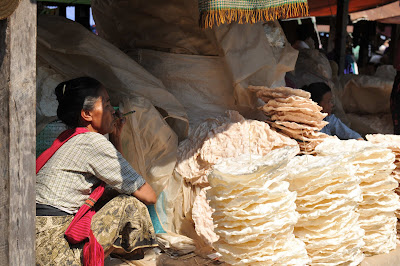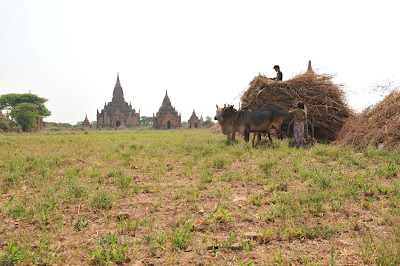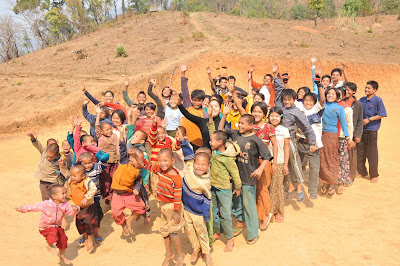
Sayadow U Tay Zaw Ba Ta in Mawlamyine


Before he smoked a cheroot, ate a piece of fruit or anything else, he spoke silently a prayer that lasted for several minutes


My lunch at the monastery. I ate after the monks by myself but before the pilgrims.
All quite tasty.

A rice cracker seller at Indein market at Inle Lake

Rice fields near Hpa-an

The notorious spider at Pindaya. Pa O are the people with turbans and indigo garb

A novice looks on with envy at this hand propelled merry-go-round

Dinner with Miss Ann in her ancestral home in Inle Lake. We were ferried to and from dinner in her private launch that whizzed through the dark waters of the lake to this formidable teak stilted house. Dinner was lovely. She has a wonderful collection of artifacts from the Shan empire that once ruled this region. The government has tried to get its hands on it.



The ice cream parlor in the market

The hand-powered ferris wheel. You can see the extra people at the top that were the weights that set the thing in motion. They jumped off at the bottom without being crushed by the swinging baskets full of people.

The pilgrims' stairway up to the Pindaya caves.

This was a dismal scene. This motorcycle had bundles of live chickens tied together by the legs and hung over the various parts of the bike.

A meat seller at the Indein market

A fresh boatload of tourists make their way across a bamboo bridge.

Boules, bacci?

Tea-leaf salad. A customary snack in Burma. Pickled tea leaves with various crunchy accompaniments. Fried garlic. roasted sesame seeds, peanuts, tiny fried prawns, and other goodies

In Bagan the parched land does not keep the farmers from growing a variety of crops. Cotton, squash, peanuts, onions, potatoes, corn and maise. a grass like corn grown and chopped for the cows.


In Bagan we had dinner at the house of our guide Kyaw (second from left). Our Yangon guide, Spring (far left), joined us with Kyaw's family. One of his sisters uses the table as a desk for teaching students.

Two Chin women on the porch of the family house

On the way to Chin state we stopped for tea and gas. The driver Tanzo sits by a poster advertising a theater group. These groups perform all over the country and we passed several open trucks on narrow mountain roads transporting the large groups of performers, sometimes as many as 30. What interested me about the poster was the variety of acts from traditional to hip urban. They often perform for 24 hrs. Everything from traditional folk tales to comedy and pop music.

Off th main street in Mindat some kids were having a tea-party, I thought. Apparently it was not that but a noodle shop.

This man we ran into in a remote village on a very steep hill. He was out for a walk.

This man was making a basket to sell in the market. He said he would get about $1.80. The young woman was shelling castor beans, which the government made everyone plant a few years ago with the hope of making bio-diesel. The effort seems to have petered out.

Orphans from the Christian orphanage in Kampelet
I told the kids who were being kept very orderly in my presence that when I counted to three they should all jump. We did this about six times until they were all absolutely hysterical. I don't think the elders approved.
In Bagan I spent an afternoon in the marketplace stocking up on things to bring to Chin state. From previous visits we knew what the most needed items were. We brought various medicines for worms, food poisoning, indigestion, pain of various kinds, bar soap and clothes washing detergent, powdered milk for breastfeeding mothers, toothbrushes and toothpaste, tiger-balm which the old people especially love, lined paper booklets, pencils, pens erasers and so on. We tried to give things out to those most in need and hoped that it would not be sold. One local guide took almost half the inventory when we asked him if he needed anything for his family. We told him he could take one of everything. Opportunity runs like water.
Chin is said to be the poorest in Burma. Things have been compounded by a rat infestation the last two years that has decimated all the crops. It also has meant that there were no seeds for planting. I met a Burmese man working for a French NGO that was trying to provide seeds to the farmers. He was there for three days trying to clear all the government obstacles. The National League for Democracy, Aung San Suu Kyi's organization, has been chastised for supplying rice to the Chin. There were two orphanages in the town of Kampelet. One, which was Christian, had fifty-six children; another Buddhist one had 200-plus. It was unclear why there were so many in this little town. Apparently they were mostly from Chin state. The Christian one was having a difficult time meeting their food needs for the children.

Chin villages around the town of Mindat










The market at Taukkyan, outside Yangon
This woman had just bought a chart from an astrologer. I bet I could tell her fortune too.
Your images and commentary are so moving. The picture of the little girl with the gun is particularly arresting. What was that about? Thanks for sharing your journey.
ReplyDeleteLaurie